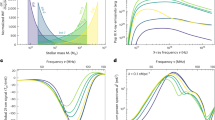Abstract
One of the most fundamental properties of the Universe is its density, or more usefully the ratio Ω = ρ/ρc of the density to the critical value required for closure. The feeling among cosmologists is that the Universe is open, with Ω perhaps in the range 0.1–0.5 (see ref. 1). In general, Ω is thought of as a parameter to be deduced from observation, but some reasons for it having a particular value have been suggested; there is a certain aesthetic appeal in having Ω = 1 (ref. 2), and the ‘anthropic principle’3 suggests that Ω should not be too far from unity if the Universe is to evolve in such a way as to allow the development of stars, and thence ourselves. Here speculations are made concerning the transition from quantum to classical gravitational behaviour near the initial cosmic singularity, and a physical process is proposed whose action leads naturally to a Universe which is open.
This is a preview of subscription content, access via your institution
Access options
Subscribe to this journal
Receive 51 print issues and online access
$199.00 per year
only $3.90 per issue
Buy this article
- Purchase on SpringerLink
- Instant access to full article PDF
Prices may be subject to local taxes which are calculated during checkout
Similar content being viewed by others
References
Gott, J. R. III, Gunn, J. E., Schramm, D. N. & Tinsley, B. M. Astrophys. J. 194, 543–554 (1974).
Dicke, R. H. & Peebles, P. J. E. in General Relativity: an Einstein Centenary Survey (eds Hawking S. W. & Israel, W.) 504–517 (Cambridge University Press, 1979).
Carter, B. in Confrontation of Cosmological Theories with Observational Data (ed. Longair, M. S.) 291–298 (Reidel, Dordrecht, 1974).
Carr, B. J. & Hawking, S. W. Mon. Not. R. astr. Soc. 168, 399–415 (1974).
Misner, C. W., Thorne, K. S. & Wheeler, J. A. Gravitation (Freeman, San Francisco, 1973).
Harrison, E. R. Phys. Rev. D1, 2726–2730 (1970).
Hawking, S. W. in General Relativity: an Einstein Centenary Survey (eds Hawking, S. W. & Israel, W.) 746–789 (Cambridge University Press, 1979).
Carr, B. J. Astrophys. J. 201, 1–19 (1975).
Gott, J. R. III A. Rev. Astr. Astrophys. 15, 235–266 (1977).
Guth, A. H. Phys. Rev. D23, 347–356 (1981).
Author information
Authors and Affiliations
Rights and permissions
About this article
Cite this article
Lindley, D. Why is the Universe open?. Nature 291, 391–392 (1981). https://doi.org/10.1038/291391a0
Received:
Accepted:
Issue date:
DOI: https://doi.org/10.1038/291391a0
This article is cited by
-
Nonconservation of baryons in cosmology—revisited
Journal of Astrophysics and Astronomy (1984)


